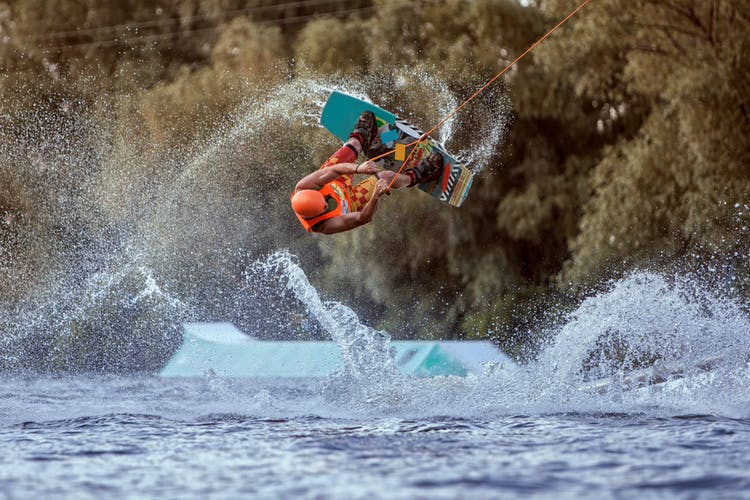Adventure-junkies listen up! Check out the must-try extreme adventures in the Philippines. Is the Philippines good for adventure travel? What kind of outdoor activities can be done around the country? Are there any water activities you can try aside from the usual inland activities? Read this article to find out more about it.
For a true adventure junkie, the Philippines is a good destination. From caving to snorkeling and scuba diving, the Philippines has it all. The country’s diverse natural wonders make it a sought-after destination among adrenaline junkies.
So whether you like outdoor adventures in the air, land, or water, you’ll find that there’s a lot of things to do in the Philippines.
15. Freediving with Sardines in Cebu
One of the most exciting, unique, and spectacular things to do in the Philippines is seeing the sardine run in Moalboal. It doesn’t have the billions of sardines, in southern Africa, the best-known sardine run in the world, but it does happen year-round. Just rent a snorkel set from the many tour operators along Panagsama Beach, jump into the water, and you’ll find them there.
14. Multi-Day Caving Adventure in Samar
When it comes to multi-day caving tours, nothing beats caving in Samar. Called the Cave Capital of the Philippines, with the largest cave system to be found there (Langun-Gobingob Caves in Calbiga), Samar has hundreds of caves that have been explored, a small portion of the total known caves.
Caving tours in Samar range from 1-day “discovery” tours, to multi-day caving tours where you get to spend a night or two inside the caves.
13. Hiking Mt. Pulag
The Philippines is not only famous for its beach tours but also for its hiking tours. Mt. Pulag in the Northern Philippines, the third highest peak in the country, is a popular trek for local mountaineers due to its famous sea of clouds.
The Mt. Pulag National Park has one of the richest biodiversity in the country, having vast forests full of pines, moss, and grass. It is a mountain worth climbing, both for its challenging trails and its natural beauty.
Hiking Mt. Pulag can last between 1-4 days, depending on the trail. Beginning climbers take the Ambangeg trail which is possible on a day trip, while the Akiki trail is a challenging, multi-day hike requiring physical fitness and training prior to the climb.
12. Wakeboarding in Camarines Sur
Wakeboarding tours are also popular as it involves riding a wakeboard on the water surface. The wakeboard is normally towed by a motorboat or by closed-course cable systems like in CamSur Wakeboarding Complex, a world-class water sports complex that is the first in the Philippines and in Asia. Aside from wakeboarding, visitors can also try water skiing, kneeboarding, and wake skiing.
11. Surfing in Siargao
Surfing tours are exciting, and the Philippines doesn’t lack for surfing destinations all over the country. There’s San Juan in La Union and Baler in Aurora, best to visit from October to April and from December to February, respectively.
The most popular, however, is Siargao Island in Surigao del Norte because of several surfing spots that can be found on the island. Its Cloud 9 reef break has even been called one of the best waves in the world. The best time to catch swells there would be from July to December.
While Siargao is the surfing capital of the country, it does not only offer good surfing breaks, but also some of the best tourist spots in the Philippines, from lagoons, caves, and the best beaches in the country.
10. Whitewater rafting in Kalinga and Cagayan de Oro
River tours are popular for both local and international travelers as it often includes whitewater rafting, a recreational outdoor activity that uses an inflatable raft to navigate a river or other body of water. This is often done on different degrees of rapids. Dealing with risk and the need for teamwork is often a part of the whitewater rafting experience.
In the Philippines, there are several places where you can go whitewater rafting. Near Manila, you can do it in Magdalena, Laguna, where you will navigate over 20 rapids in a couple of hours. The two most popular whitewater rafting destinations, however, are up north in Kalinga and down south in Cagayan de Oro.
In Kalinga, you’ll have the best time navigating the 175-kilometer-long stretch of the Chico River. You can even bundle it up with other activities in Kalinga, like getting a tattoo in Apo Whang-Od’s village of Buscalan.
Cagayan de Oro, on the other hand, is known as the Adventure Capital of the Philippines and the Cagayan River is best known for whitewater rafting. It offers rapids with varying grades that suit everyone, from beginners to whitewater rafting junkies. There are direct flights to Cagayan de Oro daily, while you can get to Kalinga by flying to Tuguegarao and then taking a 2-hour land trip.
9. Ultralight Flying in Pampanga
Ultralights are small 1- or 2-seat fixed-wing aircraft. For people who love flying and want to experience flying and being in a small aircraft, ultralight or microlight flying is a good recreational activity. You will also experience flying with the wind on your face as the ultralight has an open-air cockpit.
The Philippines is a good place to try the ultralight as the country has a good flying condition, especially during the summer season. It’s not dirt cheap, but there is no cheaper way to fly than with ultralight planes. It’s one of the top outdoor activities in the Philippines.
8. Canyoneering in Cebu
Canyoneering tours are popular because it involves hiking, bouldering, climbing, rappelling, jumping, and swimming while exploring canyons. It’s a more fun activity than just ordinary hiking. One of the best places to do so is in Cebu, where you will start in Alegria and end up in Badian.
A canyoneering day tour takes 4-5 hours and the fee covers all the gears (life vest and helmet) and a bottle of water. It will challenge you to conquer your fear of heights, and even non-swimmers can join, too. For those who want adrenaline-pumping activity while exploring canyons and falls, canyoneering in Kawasan Falls is a must.
7. Swimming with Whale Sharks
You can swim with whale sharks in some parts of the Philippines. These whale sharks grow at 32-40 feet on average, but despite their size, they are known to be docile, earning them the “gentle giant” nickname.
There are two locations in the Philippines where you can swim with whale sharks: Donsol and Oslob. Whale shark season in Donsol is from December to May, with the best time from February to April. While whale shark sighting is not assured, since these are wild creatures, you will likely see at least 5 during peak season and as many as over 40.
There have been controversies with the whale shark tours in Oslob, with the primary argument being the lack of sustainability practices in place. The Oslob local government unit, however, has taken steps to limit the number of tourists to the area to reduce the stress tourism brings to these gentle creatures.
6. Sandboarding in Ilocos Norte
Sandboarding is a recreational extreme sport similar to snowboarding but instead of snow, you ride a sandboard down or across the sand dune. It can also be done while standing up or lying on your belly. It is a popular sport in desert or coastal areas with sand dunes.
Sandboarding in the Philippines is quite a new sport and you can only do this at the sand dunes in Ilocos Norte. This sand dune is getting more and more popular not only for sandboarding but also for ATV and 4×4 riding.
5. Paragliding in Sarangani
If you want to experience flying but find skydiving too extreme, paragliding is your next best choice. It uses a lightweight and free-flying glider aircraft and requires a licensed pilot to operate it.
There are few paragliding sites across the Philippines but Sarangani in the Soccsksargen Region in Mindanao offers the best view with its rolling hills and the Sarangani Bay in the background. You can also find paragliding tours in Carmona, Cavite and Narvacan, Ilocos Sur. A paragliding trip takes only around 20 minutes, but it’s more than enough to satiate your thirst form adventure. You can try other Sarangani tours after your paragliding trip.
4. Tandem Skydiving in Cebu
Skydiving is one of the most extreme adventure sports in the world. It was developed for military use but is now one of the most popular recreational activities for adrenaline junkies. It is also one of the most expensive, given the gears and the expertise involved in doing sports.
If you can get over your fear of heights, and want a very unique perspective of seeing the Philippines from above, head to Cebu to go skydiving. While it is indeed pricey to undertake this activity, the view of the numerous beautiful beaches in Cebu surrounding the province is priceless indeed.
3. Canyon Swing in Bohol
Bungee jumping is not in the Philippines yet. However, a very good alternative to the different outdoor adventures is the canyon swing called The Plunge in Danao Adventure Park in Bohol. Unlike bungee jumping where you jump off a platform, you’ll hang by your feet in Danao and be dropped over 200 meters above the river. You’ll get around 4 seconds of free fall before swinging around 100 meters wide around the canyon.
An alternative to hanging by your feet is being dropped in a sitting down position, where you can see the ground rushing forward to meet you as you drop. Just state your preference!
If you want to tick off “bungee jumping” from your bucket list but find the 200-meter The Plunge too much, head to the Tree Top Adventure in Subic. There is a range of fun activities there, including zipline rides, but one activity similar to The Plunge is the Tree Drop. You climb up to a 60-foot high platform and experience free fall for around a second, which means that before you can scream, the free fall is over.
2. Spelunking in Sagada
Sagada, a small town in the northern part of the Philippines, is best known for its hanging coffins. However, it’s also known for adventure travel in the Philippines due to its beautiful limestone caves.
The province of Sagada has more than 60 stunning caves with spectacular rock formations, the biggest of which is Sumaguing Cave. It is an expansive cave network known for its gorgeous stalagmites, stalactites, giant rock formations, and steep descents. It is also considered as the deepest cave in the country and has a big role in the culture of the people in Sagada.
A DIY tour of the Sagada caves is not possible; a guide from the Sagada tourism office is required. While you can decide to explore Sumaguing alone, it is best to check for Sagada tours that bundle up Sumaguing with another large cave, Lumiang.
1. Coron Diving Experience
As one of the biggest archipelagos in the world, it’s not surprising that the Philippines is one of the top diving destinations worldwide. It is part of the Coral Triangle, an area in the western Pacific Ocean that’s incredibly rich in marine life. It comprises six countries — Indonesia, Malaysia, Papua New Guinea, Timor Leste, and Solomon Islands, and of course, the Philippines.
You’ll find in the Coral Triangle hundreds of species of reef-building corals, six out of the world’s seven marine turtle species, and thousands of reef fish species.
Featured Content by Guide to the Philippines

